| 14 August |
• yesterday • tomorrow |
| Memorial of Saint Maximillian Kolbe, Priest and Martyr |
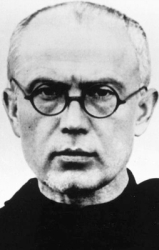
• Apostle of Consecration to Mary
• Maksymilian Maria
• Massimiliano Maria Kolbe
• Maximilian Mary Kolbe
• Rajmund Kolbe
• Raymond Kolbe
• prisoner 16670
Saint Max was born as Raymond Kolbe, the second of three sons born to a poor, pious Catholic family in Russian occupied Poland. His parents, both Franciscan lay tertiaries, worked at home as weavers. His father, Julius, later ran a religious book store, then enlisted in the army of Pilsudski, fighting for Polish independence from Russia; he was hanged by the Russians as a traitor in 1914. Raymond's mother, Marianne Dabrowska, later became a Benedictine nun. His brother Alphonse became a priest.
Raymond was known as a mischievous child, sometimes considered wild, and a trial to his parents. However, in 1906 at Pabianice, Poland at the age of twelve, around the time of his first Communion, he received a vision of the Virgin Mary that changed his life.
"I asked the Mother of God what was to become of me. Then she came to me holding two crowns, one white, the other red. She asked if I was willing to accept either of these crowns. The white one meant that I should persevere in purity, and the red that I should become a martyr. I said that I would accept them both." – Saint Maximilian
Raymond entered the Franciscan junior seminary in Lwów, Poland in 1907 where he excelled in mathematics and physics. For a while he considered abandoning the priesthood for the military, but eventually relented to the call to religious life, and on 4 September 1910 he became a novice in the Conventual Franciscan Order at age 16. He took the name Maximilian, made his first vows on 5 September 1911, his final vows on 1 November 1914.
He studied philosophy at the Jesuit Gregorian College in Rome, Italy from 1912 to 1915, and theology at the Franciscan Collegio Serafico in Rome from 1915 to 1919. On 16 October 1917, while still in seminary, he and six friends founded the Immaculata Movement (Militia Immaculatae, Crusade of Mary Immaculate) devoted to the conversion of sinners, opposition to freemasonry (which was virulently anti–Catholic), to spread use and devotion to the Miraculous Medal (which they wore as their habit), and devotion to Our Lady as the path to Christ.
During this period of work in Rome, Brother Maximilian was stricken with tuberculosis; it nearly killed him, and left him in frail health for the rest of his life. He was ordained a priest on 28 April 1918 in Rome at age 24. He earned his Doctor of Theology degree on 22 July 1922; his insights into Marian theology echo today through their influence on Vatican II.
Father Maximilian returned to Poland on 29 July 1919 to teach history in the Krakow seminary. He had to take a medical leave from 10 August 1920 to 28 April 1921 to be treated for tuberculosis at the hospital at Zakopane in the Tatra Mountains of southern Poland. In January 1922 he began publication of the magazine Knight of the Immaculate with the aim to fight religious apathy; by 1927 the magazine had a press run of 70,000 per issue. Max was forced to take another medical leave from 18 September 1926 to 13 April 1927, but the work continued. The friaries in which he was based were not large enough for his work, and in 1927 Polish Prince Jan Drucko-Lubecki gave him land at Teresin near Warsaw. There he founded a new monastery of Niepokalanów, the City of the Immaculate which was consecrated on 8 December 1927. At its peak the Knight of the Immaculate had a press run of 750,000 copies a month. A junior seminary was started on the grounds in 1929. In 1935 the house began printing a daily Catholic newspaper, The Little Daily with a press run of 137,000 on work days, 225,000 on Sundays and holy days.
Not content with his work in Poland, Maximilian and four brothers left for Japan in 1930. Within a month of their arrival, penniless and knowing no Japanese, Maximilian was printing a Japanese version of the Knight; the magazine, Seibo no Kishi grew to a circulation of 65,000 by 1936. In 1931 he founded a monastery in Nagasaki, Japan comparable to Niepokalanów. It survived the war, including the atomic bombing, and serves today as a center of Franciscan work in Japan.
In mid-1932 Max left Japan for Malabar, India where he founded a third Niepokalanów house. However, due to a lack of manpower, it did not survive.
Poor health forced him to curtail his missionary work and return to Poland in 1936. On 8 December 1938, Niepokalanów started its own radio station. By 1939 the monastery housed a religious community of nearly 800 men, the largest in the world in its day, and was completely self-sufficient including medical facilities and a fire brigade staffed by the religious brothers.
Father Max was arrested with several of his brothers on 19 September 1939, less than three weeks into the Nazi invasion of Poland. Others at the monastery were briefly exiled, but the prisoners were released on 8 December 1939, and the men returned to their work. Back at Niepokalanów, Kolbe continued his priestly ministry. The brothers housed 3,000 Polish refugees, two-thirds of whom were Jewish, and continued their publication work, including materials considered anti-Nazi. For this work the presses were shut down, the congregation suppressed, the brothers dispersed, and Maximilian was imprisoned in Pawiak prison in Warsaw, Poland on 17 February 1941.
On 28 May 1941 he was transferred to the Auschwitz concentration camp in occupied Poland and branded as prisoner 16670. He was assigned to a special work group staffed by priests and supervised by especially vicious and abusive guards. His calm dedication to the faith brought him the worst jobs available, and more beatings than anyone else. At one point he was beaten, lashed, and left for dead. The prisoners managed to smuggle him into the camp hospital where he spent his recovery time hearing confessions. When he returned to the camp, Maximilian ministered to other prisoners, including conducting Mass and delivering communion using smuggled bread and wine.
In July 1941 there was an escape from the camp. Camp protocol, designed to make the prisoners guard each other, required that ten men be slaughtered in retribution for each escaped prisoner. Francis Gajowniczek, a married man with young children, was chosen to die for the escape. Maximilian volunteered to take his place, and died as he had always wished – in service.
7 January 1894 at Zdunska Wola, Poland as Raymond Kolbe
• 14 August 1941 by lethal carbonic acid injection after three weeks of starvation and dehydration at the Auschwitz death camp in Nazi-occupied Poland
• body burned in the ovens and ashes scattered
• some relics have been preserved and distributed by the friars at Niepokalanów, Poland
• 17 October 1971 by Pope Paul VI
• his beatification miracles include the July 1948 cure of intestinal tuberculosis of Angela Testoni, and August 1950 cure of calcification of the arteries/sclerosis of Francis Ranier
• 10 October 1982 by Pope John Paul II
• declared a martyr of charity
• drug addicts; against drug addiction
• families
• journalists
• prisoners; political prisoners
• pro-life movement
• Catholic Saints Info Podcast
• Jerry Usher
• SaintCast: interview with Auschwitz survivor Tadeusz Raznikiewicz who saw the last days of Saint Maximilian
• YouTube PlayList
• T J Berden: Inside Saint Maximilian's Cell
Kolbe is the patron saint of our difficult century. – Pope John Paul II
Courage, my sons, Don't you see that we are leaving on a mission? They pay our fare in the bargain. What a piece of good luck! The thing to do now is to pray well in order to win as many souls as possible. Let us, then, tell the Blessed Virgin that we are content, and that she can do with us anything she wishes. – Saint Maximilian Kolbe
The most deadly poison of our times is indifference. And this happens, although the praise of God should know no limits. Let us strive, therefore, to praise Him to the greatest extent of our powers. – Saint Maximilian Kolbe
For Jesus Christ I am prepared to suffer still more. – Saint Maximilian Kolbe
No one in the world can change Truth. What we can do and should do is to seek truth and to serve it when we have found it. The real conflict is the inner conflict. Beyond armies of occupation and the hecatombs of extermination camps, there are two irreconcilable enemies in the depth of every soul: good and evil, sin and love. And what use are the victories on the battlefield if we ourselves are defeated in our innermost personal selves? – Saint Maximilian Kolbe in the last issue of the Knight
https://catholicsaints.info/saint-maximilian-kolbe/

• Arnoldus of Soissons
• Arnoul of Soissons
• Arnulphus of Soissons
French nobleman. Distinguished career soldier under King Robert and King Henry I. Benedictine monk at the monastery of Saint Medard, Soissons, France c.1060. Hermit, living for three years in a tiny cell with almost no contact with the outside. Called to return to his community, he became abbot of his house. He tried to refuse the responsibility; legend says he tried to flee the house, but that a wolf blocked his path and forced him to return. Priest. Bishop of Soissons, France in 1081. When first offered the bishopric, he replied, "Leave a sinner to offer to God some fruits of penance; and compel not a madman to take upon him a charge which requires so much wisdom." He was ordered to take the position, but found it more than he could handle. When an interloper drove him from his see, he took the opportunity as a sign, resigned, and returned to monastic life. Founded a monastery at Aldenburg, Flanders where he lived the rest of his days.
1040 at Flanders, Belgium
• 1087 at the monastery at Aldenburg, diocese of Bruges, Flanders, Belgium of natural causes
• miracles reported at his tomb were investigated and approved by a council at Beauvais, France in 1121
• relics translated to the church of Saint Peter, Aldenburg, Belgium in 1131
• brewers
• hop pickers
• millers
• music
• to find lost articles
• bishop blessing a burning castle
• bishop wearing a coat of mail under his cope
• bishop with a fish with a ring in its mouth
• bishop with a mash rake (a beer brewing tool)
• washing the feet of the poor
https://catholicsaints.info/saint-arnulf-of-soissons/
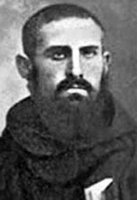
• Eusebio of Saludes
• Eusebius
Feeling a call to a religious vocation, Ezequiél joined the Franciscan Capuchins on 2 February 1907, taking the name Eusebius; he made his profession as a lay brother on 2 February 1908. He was sent to a Franciscan house in Cuba in 1919 where he served as a carpenter and catechist until health problems forced his return to Spain in 1927. On 21 July 1936, in the early days of the Spanish Civil War, Brother Eusebius was imprisoned with four other Franciscans in the Jesuit church in Jove, Spain for the offense of being actively Christian. He was given several weeks of confinement to renounce the faith; he refused. Martyr.
19 February 1885 in Saludes, León, Spain
14 August 1936 in Jove, Asturias, Spain
• 13 October 2013 by Pope Francis
• beatification celebrated at the Complex Educatiu, Tarragona, Spain, presided by Cardinal Angelo Amato
https://catholicsaints.info/blessed-ezequiel-prieto-otero/

Studied at the Seminary of Valencia, Spain. Priest, ordained in 1894 in the archdiocese of Valencia. Served 40 years as parish priest in La Pobla Llarga, Spain. Noted for his charity and his ministry to the sick. In the persecutions of the Spanish Civil War, he was forced to briefly abandon his parish, but returned as he could not abandon his parishioners. Arrested by anti–Catholic militiamen, some of whom he had baptized, on 14 August 1936, hustled out of town, and executed. Martyr.
13 March 1874 in Gandía, Valencia, Spain
• shot on 14 August 1936 on the road outside in Picassent, Valencia, Spain
• body left on the side of the road; discovered three days later and given a proper burial by local Christians
11 March 2001 by Pope John Paul II
Long live Jesus in the Eucharist! – Blessed Vincente's dying words
https://catholicsaints.info/blessed-vicente-rubiols-castello/
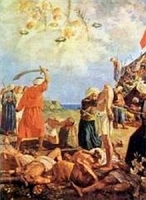
Martyrs of Otranto
An aged lay man artisan in Otranto, Italy, Antony was known for his personal piety. In 1480 Otranto was invaded by Turks who offered the inhabitants the choice between death and conversion to Islam. Antony was chosen as spokesman for the town, and explained to the Turks that Otranto chose Christ. Martyred with 812 other residents of Otranto whose names have not come down to us.
hacked to pieces on 13 August 1480 in Otranto, Lecce, Italy
• 14 December 1771 by Pope Clement XIV (cultus confirmed)
• 6 July 2007 by Pope Benedict XVI (decree of martyrdom)
Sunday 12 May 2013 by Pope Francis in Rome, Italy
Otranto, Italy
https://catholicsaints.info/saint-antony-primaldo/

Known as a pious child. Studied at the seminary of Valencia, Spain, and at the Spanish College and Gregorian University in Rome, Italy. Priest in several parishes of the archdiocese of Valencia. Professor at the Valencia seminary. Active supporter of Catholic Action in his parishes. Founded parochial schools. In the persecutionsSpanish Civil War, he and some fellow priests went into hiding at his brother's home. Arrested by –Catholic militianmen on on the night of 13 August 1936. Martyr.
21 February 1887 in Chulilla, Valencia, Spain
shot in the early morning of 14 August 1936 in El Saler, Valencia, Spain
11 March 2001 by Pope John Paul II
https://catholicsaints.info/blessed-felix-yuste-cava/

Joined the Dominicans in 1605. Priest. Missionary to Pangasinan, Philippines in 1611. Taught theology at the Colegio de Santo Tomas. Missionary to Japan in 1623 during a time of violent persecution of Christians. Worked with local converts for ten years, aided by Saint Francis Shoyemon. Captured by authorities in July 1633, he was imprisoned, tortured and finally murdered for refusing to renounce his faith. Martyr.
February 1589 in Régil, Guipúzcoa, Spain
14 August 1633 in Nishizaka, Nagasaki, Japan
18 October 1987 by Pope John Paul II
https://catholicsaints.info/saint-domingo-ibanez-de-erquicia/
Werenfrid, Werenfried
Benedictine monk. Priest. Missionary. Worked with Saint Willibrord of Echternach to evangelize the Frisians.
in England
• c.780 at Arnheim, Netherlands
• his coffin floated down river to finally settle at Elst, Netherlands
• the incident is still commemorated on the Overbetuwe province coat of arms
• against gout
• against stiff joints
• vegetable gardeners
• Arnheim, Netherlands
• Elst, Netherlands
• Westervoort, Netherlands
• priest vested for Mass holding a ship with a coffin in it
• dead priest laid in a ship
https://catholicsaints.info/saint-werenfridus/

Imperial Roman patrician. Priest. Pope Liberius subscribed to the Arian formula of Sirmium; when he was permitted by the Emperor Constantius to return to Rome, Eusebius, an ardent defender of the Nicene Creed, publicly denounced them both. He was imprisoned, and died seven months later. Confessor.
• 357 of maltreatment in prison in Rome, Italy
• relics in church of San Eusebio, Rome
https://catholicsaints.info/saint-eusebius-of-rome/

Marcel, Marcello
Civil magistrate noted for his honesty, justice and mercy. Chosen bishop of Apamea, Syria in the late 4th century. Murdered by pagans for enforcing the 385 decree of emperor Theodosius for the destruction of idols. Martyr.
Cyprus
389 in Apamea, Syria
https://catholicsaints.info/saint-marcellus-of-apamea/
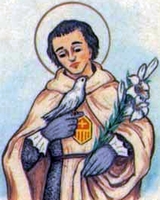
William
Born to the Italian nobility. Mercedarian lay knight, receiving the habit from Saint Peter Nolasco. Known as an innocent and virtuous young man.
Italy
Mercedarian convent in Barcelona, Spain of natural causes
https://catholicsaints.info/blessed-guglielmo-of-parma/
Fachtna, Facanano
Monk. Abbot. Founded a monastery and school in the Rosscarbery area which became a celebrated seat of learning and gained an international reputation for study of sacred scripture. Priest. First bishop of Ross, Ireland.
c.600
• Kilfenora, Ireland, diocese of
• Ross, Ireland, diocese of
https://catholicsaints.info/saint-fachanan-of-ross/
Married. Her first husband died fighting the Saracens. Her second husband became a monk. Athanasia turned their home into a convent, then built Timia Abbey to house a larger congregation. Her reputation for holiness spread, and she became an advisor to Empress Theodora.
Aegina
860 at Timia Abbey of natural causes
https://catholicsaints.info/saint-athanasia-of-timia/
• Ursicius of Illyrium
• Ursicin, Ursicino, Ursicinus
Tribune in the imperial Roman army. Martyred in the persecutions of Diocletian.
Illyrium
beheaded in 304 at Nicomedia (in modern Turkey)
https://catholicsaints.info/saint-ursicius-of-nicomedia/
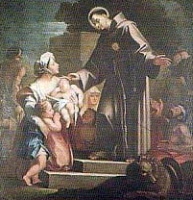
Franciscan lay-brother at Scotameto, Italy.
Monte Fabri, Italy
1490 of natural causes
by Pope Clement XIV
https://catholicsaints.info/blessed-sanctes-brancasino/

Lay Dominican catechist. Martyr.
Japan
14 August 1633
18 October 1987 by Pope John Paul II
https://catholicsaints.info/saint-franciso-shoyemon/
Bishop of Todi, Italy c.523. Zealous opponent of the heresy of Arianism. Preached against the excesses and loose lives of the local nobility - and was murdered by the servants of those nobles. Martyr.
528
https://catholicsaints.info/saint-callistus-of-todi/
Everard
Monk. Founder and first abbot of Einsiedeln Abbey in Switzerland.
Swabia, Germany
958
https://catholicsaints.info/saint-eberhard-of-einsiedeln/
Martyred in the persecutions of Maximian Herculeus.
late 3rd century Palestine
https://catholicsaints.info/saint-eusebius-of-palestine/
Martyred in Africa.
https://catholicsaints.info/saint-demetrius-of-africa/
Thousands of people were murdered in the anti-Catholic persecutions of the Spanish Civil War from 1934 to 1939. I have pages on each of them, but in most cases I have only found very minimal information. They are available on the CatholicSaints.Info site through these links:
• Blessed Ángel de la Red Pérez
• Blessed Ángel Marina Álvarez
• Blessed Antonio Luque Jurado
• Blessed Antonio María Martín Povea
• Blessed Antonio Trancho Andrés
• Blessed Arsenio de la Viuda Solla
• Blessed Basilio González Herrero
• Blessed Dionisio Pérez García
• Blessed Eduardo Sáinz Lantarón
• Blessed Ezequiél Prieto Otero
• Blessed Félix Yuste Cava
• Blessed Fernando García de Dios
• Blessed Francisco Santos Cadierno
• Blessed Joaquín Frade Eiras
• Blessed Jocund Bonet Mercadé
• Blessed José García Librán
• Blessed Luis Suárez Velasco
• Blessed Manuel Fernández-Herba Pereira
• Blessed Natalio Camazón Junquera
• Blessed Ovidio Bravo Porras
• Blessed Pedro López Delgado
• Blessed Ricardo Atanes Castro
• Blessed Sebastián Sáinz López
• Blessed Segundo Pérez Arias
• Blessed Vicente Rubiols Castelló
• Elisabetta Renzi
• Lorenzo da Fermo
CatholicSaints.Info Portable Edition